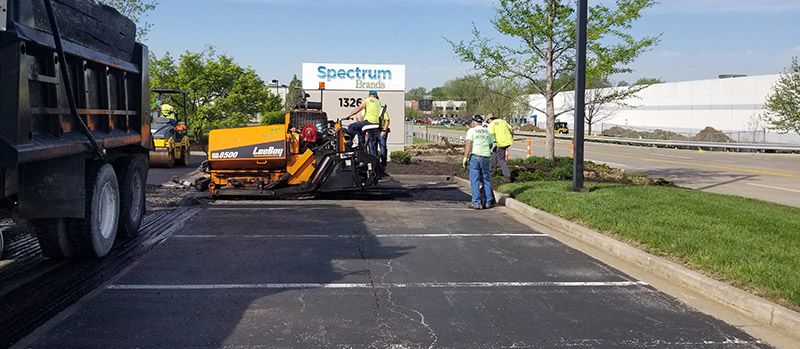The 8-Second Trick For A1 Professional Asphalt & Sealing Llc
Table of ContentsGetting My A1 Professional Asphalt & Sealing Llc To WorkA1 Professional Asphalt & Sealing Llc - QuestionsThe Greatest Guide To A1 Professional Asphalt & Sealing LlcA Biased View of A1 Professional Asphalt & Sealing LlcThe 15-Second Trick For A1 Professional Asphalt & Sealing Llc

The oil in a cars and truck engine is not just oil. The REOB includes all the ingredients that were in the waste oil as well as the wear metals from the engine (mainly iron and copper).
By making many blends utilizing different REOB samples and different asphalt binders, the variants greatly can be averaged out. Several States provided examples of known REOB make-up to TFHRC scientists, who evaluated the samples to compare the percentage of included (recognized) REOB to the located (evaluated) quantity. The evaluations revealed an equivalent portion of added and located REOB.
Everything about A1 Professional Asphalt & Sealing Llc
They got an overwhelming action. The TFHRC researchers evaluated 1,532 examples from 40 States, one Canadian province, and 2 Federal Lands Highway departments. They analyzed each example twiceamounting to more than 3,000 analyses. None of those States recognized that the asphalt they were getting had REOB. One State urged its samples had no REOB.
Of the 1,532 samples evaluated, 12 percent included REOB, and some included considerably high levels of it at 1020 percent. The highest degree was 34 percent in an example from Texas, which TxDOT had used in a patching substance. This testing also revealed the visibility of phosphoric acid in 11 percent of the examples, and 2 percent included ground tire rubber.
2 years back at TRB's annual meeting, the Federal scientists held an REOB workshop and provided the searchings for of their research laboratory evaluations to a standing room-only group. Although some companies do not specifically outlaw REOB, they do impose physical examinations that prevent its useeffectively a ban. cold mix vs hot mix asphalt. Others do not ban it by requirements, however have agreements with asphalt distributors to prevent making use of REOB
A1 Professional Asphalt & Sealing Llc for Beginners
A handful do allow REOB, some within specific limits. As an example, Ohio and Texas restriction degrees to much less than 5 percent of the asphalt. To develop a trustworthy examination method that all States can make use of, the TFHRC researchers established a round-robin examination plan. The participants are 11 State freeway agencies (Illinois, Massachusetts, Minnesota, Mississippi, Montana, North Carolina, Oklahoma, South Carolina, Texas, Vermont, and Wyoming), 2 independent testing labs, the Ministry of Transport in Ontario, Queen's University in Ontario, and an Ontario paving contractor.
The individuals are testing the examples separately utilizing the guidelines provided by the TFHRC scientists. The result will certainly be a suggested AASHTO test approach that any type of State can adopt and make use of.
The sidewalk with REOB, which lies 0.6 mile (1 kilometer) from the sidewalk without REOB, has the same subgrade, traffic thickness, and environment. However, the section of Highway655 with 5 to 10 percent REOB showed considerable fracturing. In this example, the visibility of REOB was the recognized reason for cracking at a low temperature levels.
A section of examination pavement in Minnesota (MN1-4) located to include REOB additionally cracked too soon. The pavement done well for the initial 3 to 4 years, however after that began to break.
A Biased View of A1 Professional Asphalt & Sealing Llc
The tests were not look at this website considerable, however they showed that at degrees of 6 percent or even more, the tensile toughness of the asphalt dropped significantly. At a level of 3.5 percent REOB, the variant in the physical examination techniques was higher than the impact of REOB. As a matter of fact, it was difficult for scientists to analyze whether REOB existed.

One binder criterion taken into consideration is the distinction between the reduced temperature level essential specification temperature for stiffness (S) in the flexing light beam rheometer and the flexing beam of light rheometer creep slope (m-value) noted as Tcritical. TC = TC (S) TC (m-value). Examination of this specification is still ongoing. Two independent study groups, one from AASHTO and the other from the Asphalt Institute, wrapped up that more research is required on making use of REOB in asphalt.
Previously, all asphalt screening determined design residential or commercial properties such as rigidity. These tests do not show what materials had been contributed to the asphalt. One sample obtained during the TFHRC research study had a very strange analysis. The sample had the adhering to test results: Superpave PG 64-28 with a high temperature level grade of 67.3 Tcritical on the flexing beam rheometer was 6.7 levels Celsius.

Not known Facts About A1 Professional Asphalt & Sealing Llc
These results demonstrate there are weak points in the standard design screening methods that may be exploited. The manufacturer might have an economic advantage and the product passes all the standardized examinations, however the product may not be helpful to making sure long-term performance. To resolve this concern and the development of new asphalt additives and extenders, TFHRC is starting a research study program to use portable spectroscopic gadgets, x-ray fluorescence spectroscopy, and Fourier transform infrared spectroscopy to make it possible for evaluations to be carried out in the field instead of having to take examples back to the lab.